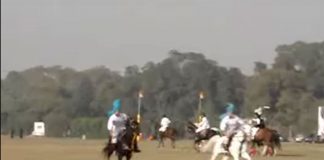
Q: I am a very small adult rider so I can ride larger ponies. I recently started riding a 14.2-hand gelding and I’d like to show in the hunter division. He’s a good show pony, but as an adult my options are limited. I can show him in regular classes, but I’m concerned that his shorter strides will be a liability. Are there any exercises I could do to help him lengthen his strides so that he’ll be able to handle the courses better?
The biggest problem is one of suitability. It’s a subjective judging criteria but one that’s considered nonetheless. As a judge I’d have to determine if the pony was a suitable mount for you. His height makes him a large pony, and if you’re indeed petite—not just short or short-legged—you and this pony may indeed be a pleasant match. I’d also have to decide if the pony is suitable for the task, which is jumping a course set for horses. No one, especially the judge, wants to see a pony struggle to climb up and over an oxer. But as many equestrians know, there are plenty of ponies capable of cruising around such a course with ease. If this little gelding is of good quality, a super mover and stylish jumper then suitability to purpose shouldn’t be an issue.
The problem with strides, however, can’t be ignored. Simply put, the pony isn’t going to cover as much ground per stride as the typical horse. Personally, I wouldn’t try to reconfigure Mother Nature by trying to stretch the pony’s strides. Chances are you’d end up with a galloping pony that jumped flat, pulled rails and still didn’t make the counts through the lines. Instead, I’d focus on flatwork that encouraged him to work long and low and reach for the bit. Then I’d resign myself to adding one stride—and only one—in every line. For example, a line that’s set at 60-feet would be four strides for a horse and five for your pony. That formula (pony vs. horse) is standard in the hunter division.
Ultimately your success in the show ring will vary depending on the competition and the judge’s personal viewpoint. But a truly fancy pony that jumps well, gets easy flying lead changes and seems to be a good match for its petite lady rider can place above horses, particularly if those horses commit errors on course. (At least they can on my scorecard).
–Cindy Hale
Ask your questions on the horseillustrated.com Forums >>
See more Expert Q&As >>
Submit your Ask the Expert question >>






Good advise, but I wonder why only a judge opinion would really matter. If a pony can do what the horse can do, the pony should be judged on itself.
I have found it to be case of having to add a stride in the hunter division when I was showing my quarterhorse. I was more into him looking good instead of looking rushed; sometimes we would win but for the most part is was 3rds & 4ths.
I think this is great advice. However, I have never figured out the stride issue. Why is their a standard set in stone? Every horse is different and a longer stride on one may look good but the same stride on another can be awkward. As in the case with this pony.
I don’t see why there’s prejudice against small horses and ponies. I wasn’t allowed to show my horse in 4-H because he was under 14.2. I was taught that the size of horse and rider should be matched.